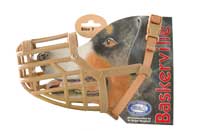How to teach your dog to wear a muzzle
There can be many times when it is useful to use a dog muzzle.
Here are just a few ideas:
- It keeps things safe,
- Muzzle prevents your dog from scavenging
- Barking can also be inhibited by a muzzle
- A muzzle can actually calm your dog a little, possibly as a result of the gentle pressure that it exerts around the back of the neck and over the nose
- and if your dog is wearing a muzzle, it's quite likely that people will stay clear and keep their dogs away from yours to (which can be a helpful step with some behavioural issues)
There's a superb article by Karen Pryor on the varied use of muzzles here.

The same can be true for any "nose gear" : gentle leaders, haltis, hushers, or muzzles.
Therefore, irrespective of how your dog may feel it can be significantly worth your while to help to accustom your dog to the halti or muzzle before you actually need to use it.
So, here are some notes on counter-conditioning your dog : helping them the FEEL differently about the muzzle, or other nose gear.
Introducing a muzzle - for a dog who has never seen one
A muzzle needs to be introduced gradually so that the dog becomes used to it. Really this is best done when your dog is just a tiny puppy. You wouldn't really think about a muzzle at that stage, but if you get your puppy used to their nose being held and wearing a gentle leader or muzzle when they are only 10 weeks old, they will be unlikely to have any problems. Then if you actually, unfortunately, do need one later, it will be much easier.
Here are some steps for simple muzzle introduction. Practice each step for just a minute or so at a time, and repeat 2 or 3 times a day. At any point if your dog seems to appear fearful or back off, then stop. Have a couple of days off and then start at the beginning again, progressing more slowly.
1. Get your dog to know that the muzzle is a nice thing. Simply let them sniff it and give a treat. Repeat that a few times.
2. Get your dog used to putting their chin on your hand. For this, hold your hand towards your dog, cupped, ready for their chin. Reward them if they move a little towards your hand. Each time, they should be putting their heads closer to your hand and then finally resting their chin on your hand.
3. Commence to holding the muzzle cupped in your hand with the cup facing outwards. Pop a treat in to it, supported by your hand. Let your dog see you put the treat in there. And then hold the muzzle towards them. They should be quite happy to pop their snout in there to get the treat.
4. Gradually build up the time they keep their nose in there. The Blue Cross uses an interesting technique of putting peanut butter inside the muzzle to keep the dogs nose inside there for longer - have a look - the technique may work for you - Blue Cross, Peanut Butter, Muzzle introduction.
5. Once they are comfortable, then you can start to close the clip, just for a second to start with. Then unclip, and give a treat. Again gradually build up the time
That's it really. Continue to have some practice. Do some training with the muzzle on and play a game with your dog. It should all be a pleasant experience for them.
Muzzle Don'ts.....
Never "reward" them if they try to take it off - that means ignoring pawing the muzzle, and not saying anything like "there there, it's ok" or patting. We need to keep them distracted either with training, treats, or a paw game for instance. Never tell them off either! Carefully introduced, we should never find ourselves in this situation.
Do not do this in the location where your dog may be aggressive.
If your dog behaves aggressively at any level during your muzzle introduction exercise, then please don’t continue to force the issue. Please contact us instead.
If your dog is scared of the muzzle before you start, please get help from a qualified behaviourist to ensure that your dog's unique muzzle fear problems can be addressed.
Here are some good muzzle introduction videos
Chirag Patel Muzzle Introduction - click here
Blue Cross Muzzle Introduction- click here
NOTES :
A muzzle won't help to stop aggression, nor change the motivation behind the behaviour. And thus, we recommend that you use a muzzle in conjunction with a behaviour and training program. For more help, click here - www.capbt.org. Your behaviourist will then be able to help you with how to introduce the muzzle and also when and where it's best used.